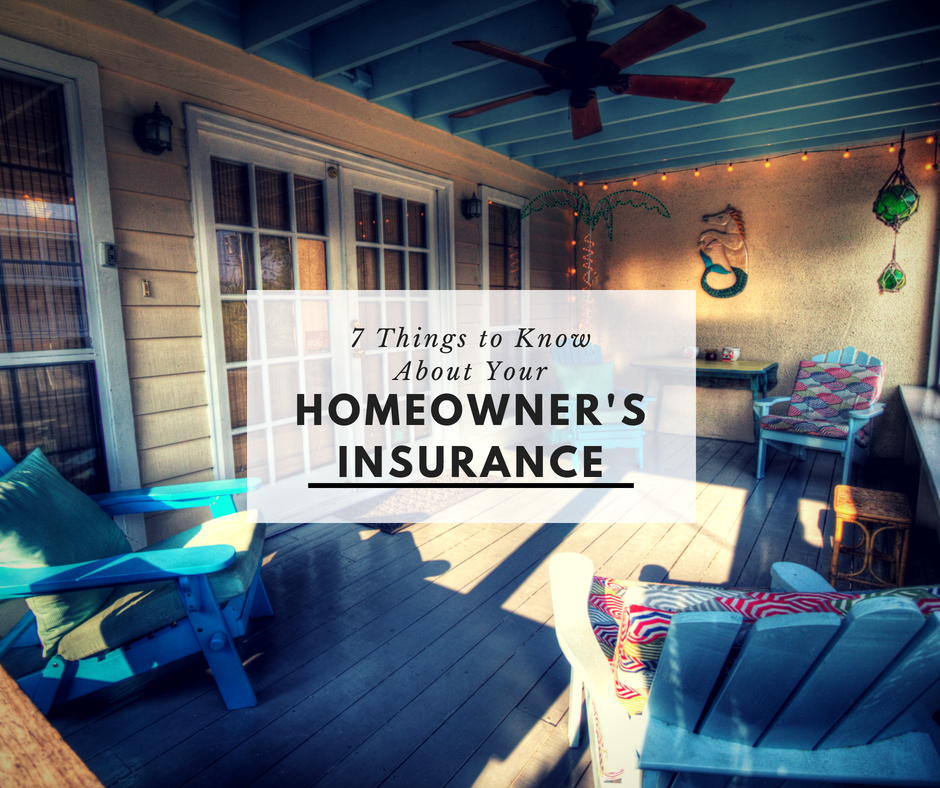
The Insurance Journal reports that 40% of Americans don’t know if their Homeowner’s Insurance will replace their belongings and home in the event of a disaster. Do you know what to look for when analyzing your policy?
Often times when I am assisting a real estate client in buying or selling a home, the topic of insurance comes up. A lot of my clients have been able to save a substantial amount of money by switching insurance companies. Some of the most important aspects of your homeowner’s insurance policy are: dwelling coverage, personal property, personal liability, loss of use, ordinance or law, deductibles, and premiums.
Dwelling Coverage
The dwelling coverage amount is determined by the insurance company as they look at the physical characteristics of your home. The insurance company should be looking at the size, quality of finishes, layout, porches, and decks. The idea is to have enough coverage, so you can rebuild the home in the event of a total loss.
Most insurance companies will pay a percentage above the dwelling coverage amount if the home has to be rebuilt. For example, if you have $200,000 in dwelling coverage and the insurance company will pay 110%, your actual coverage is $220,000. These plans are a little risky in the market today because of the cap on what they will pay and the increasing costs to rebuild.
Another type of dwelling coverage is guaranteed replacement cost, but this is fairly rare now. This means the insurance company will pay to rebuild 100% of the home, no matter what the dwelling coverage amount is.
Personal Property
Most of us have accumulated personal property over the years. We did not go out and buy everything we have in one weekend. Could you imagine what it would feel like to have your home and all of your belongings wiped out by a tornado? Yikes!!! You would have to buy new clothes, bedroom furniture, dishes, cars, etc.
We are talking about tens of thousands of dollars to piece your life back together. Absolutely devastating!!! It is so important to make sure you have adequate personal property coverage included in your homeowner’s insurance.
Personal Liability
Personal liability is what covers you if something happens to someone else while they are on your property. Fox News in Salt Lake City, UT reported Two taken to hospital after deck collapses during a college party at North Logan home. Police estimated 60 people were on the deck, and many people fell 10-15 feet to the lower level.
Who do you think covered the medical bills for those who were injured? Although the article doesn’t report what happened from an insurance standpoint, I have a pretty good guess…
More than likely the health insurance companies subrogated the claim to the homeowner’s personal liability insurance. Subrogated is a fancy word for saying the health insurance company assigned the legal liability to a third-party.
This is a great place to mention an Umbrella policy. An Umbrella policy can extend your personal liability over your home and car insurance up to $1,000,000 or more. It is great to have the additional personal liability for $200 to $300 a year.
Loss of Use
In the event of a partial or total loss on your home, you will need to find somewhere to live while the home is rebuilt. Loss of use coverage will pay for your temporary housing. Depending on the level of damage, it might be a couple days or 10 months to rebuild your home.
Ordinance or Law Coverage
Have you ever even heard of this before? Let’s say your home was built in 1985 and you have a total loss on your home. Your insurance company was insuring a home built by 1985 standards. More than likely your city or county has changed the building code over the last three decades. Ordinance or Law coverage is what is going to cover the gap between the 1985 and 2018 building standards.
Deductibles
Low deductibles are nearly a thing of the past. In an effort to keep premium increases down, insurance companies have been increasing deductibles. A higher deductible transfers more risk to you. In Colorado, we have several wind and hail storms each year that create a lot of damage. Therefore, premiums and deductibles have been going up.
It is really common to see different deductibles for different events. For example, if an uninsured motorist loses control of their car and smashes into your home, that might be a $1,000 deductible. On the other hand, if you have a bad hail storm that deductible might be $1,000, $2,500, or $5,000.
Premiums
I intentionally left premiums for the last point. Yes, the premium is absolutely important, but the premium is not the only thing that is important. A friend and client of mine was recently telling me about how his homeowner’s insurance premium had gone up 60% in the last three years. What a joke! After he called his insurance company, he was able to get it down some. I am most proud of the next step he took. He shopped his insurance and was able to save a lot of money!!!
For more tips on how to save money, check out 9 Unique Ways To Save Money in 2018!
Final Thoughts On Your Home Owner’s Insurance
Please, please, please… Go and pull your homeowner’s insurance policy. Then you can make sure your dwelling coverage, personal property, personal liability, loss of use, ordinance or law, deductibles, and premiums are all reasonable. If you have questions, you should call your insurance agent. Furthermore, you should consider calling a few different agents or insurance brokers to make sure you are getting the best coverage for the best price.